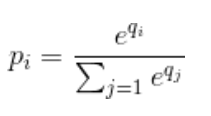0
与标准归一化相比,Softmax有一个不错的属性。
它对神经网络的低刺激(想想模糊的图像)的反应分布相当均匀,对高刺激(想想清晰的图像)的概率接近0和1。
只要比例相同,标准规范化就无关紧要。
看看soft max输入大10倍时会发生什么,即神经网络获得清晰的图像并且许多神经元被激活
>>> softmax([1,2]) # blurry image of a ferret
[0.26894142, 0.73105858]) # it is a cat perhaps !?
>>> softmax([10,20]) # crisp image of a cat
[0.0000453978687, 0.999954602]) # it is definitely a CAT !
然后将其与标准归一化进行比较
>>> std_norm([1,2]) # blurry image of a ferret
[0.3333333333333333, 0.6666666666666666] # it is a cat perhaps !?
>>> std_norm([10,20]) # crisp image of a cat
[0.3333333333333333, 0.6666666666666666] # it is a cat perhaps !?
收藏
 理工酷
理工酷
 资源下载
资源下载
 由于指数的原因,计算起来很耗时。为什么不简单地执行Z变换以使所有输出均为正,然后通过将所有输出除以所有输出之和来进行归一化?
由于指数的原因,计算起来很耗时。为什么不简单地执行Z变换以使所有输出均为正,然后通过将所有输出除以所有输出之和来进行归一化?







